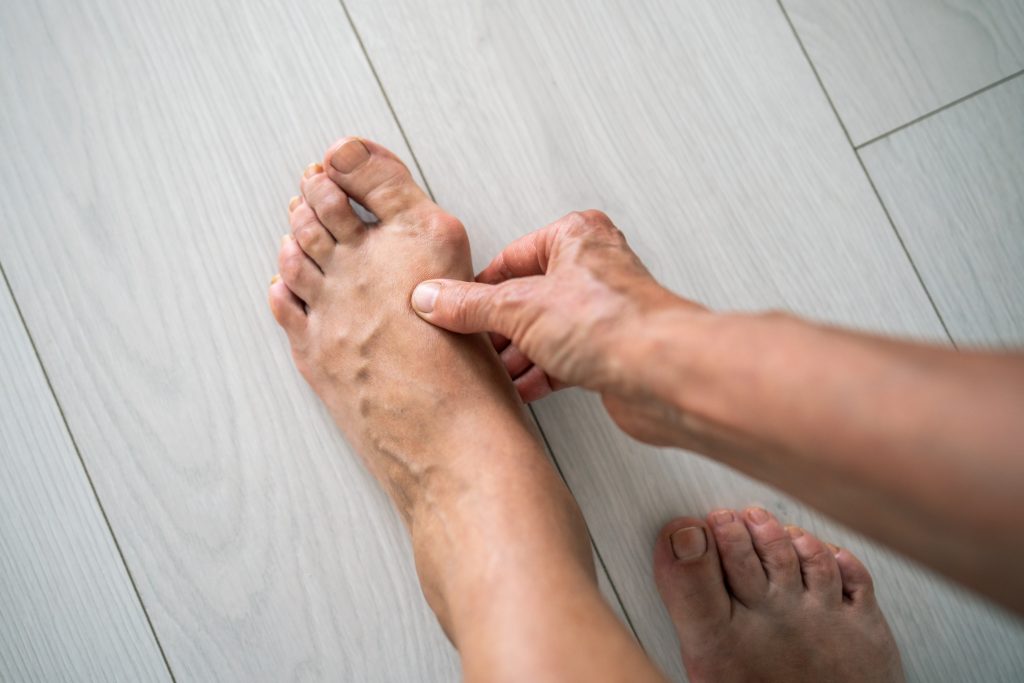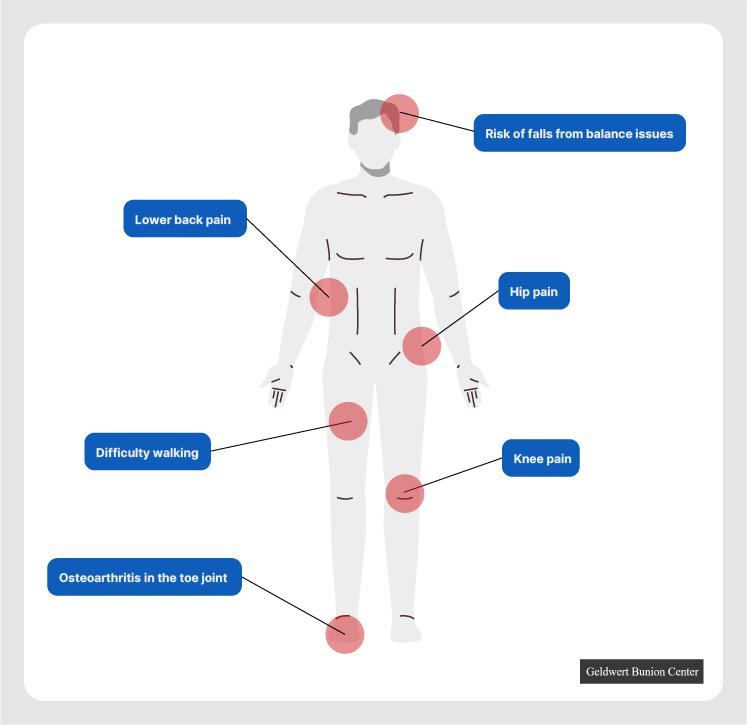
The long-term effects of bunions can be serious; they can change how you walk, affect other joints, and even limit your mobility over time. Let’s take a look at some common bunion long term effects, and discuss why you should treat bunions before they cause serious health issues.
Bunion Long Term Effects: What Happens When Bunions Go Untreated
Around 1 in 4 adults over 60 develop bunions, with women being more affected than men due to hormonal differences, footwear choices, and genetic factors. Here are the stages of bunion development, and what can happen when bunions are left untreated.
| Bunion Long Term Effects | ||
|---|---|---|
| Stage | Approximate Timeframe | Effects |
| Initial Discomfort | 1-2 years | Occasional pain when walking or movingMild swelling around the big toe jointDifficulty finding comfortable shoes |
| Functional Limitations | 2-5 years | Chronic pain affecting daily activitiesReduced range of motion in the big toeChanges to gait and posture |
| Secondary Complications | 5-10 years | Development of arthritis in the big toe jointFormation of hammertoes or claw toesHigher risk of falls due to altered balance |
| Systemic Effects | 10+ years | Knee, hip, and lower back painSignificant mobility limitationsReduced overall quality of life |
Source 1 | Source 2 | Source 3 | Source 4
How Bunions Affect Feet and Other Parts of the Body

Initially, a bunion rubs against your shoes, leading to persistent pain, redness, and irritation. Over time, the bunion deformity places abnormal pressure on the cartilage inside the big toe joint, often leading to osteoarthritis in the big toe joint.
When your big toe can’t function properly, your walking pattern (gait) naturally changes to avoid pain. This uneven walking style can strain other parts of the body, which is why many bunion patients also experience pain in their knees, hips, or lower back.
Severe bunions can make walking painful and limit your ability to stay active. Older adults with untreated bunions may even face a higher risk of falls because of balance problems and changes in their foot mechanics.
How to Prevent Long Term Effects From Bunions
As you can see, leaving a bunion untreated for a few years can have serious consequences when it comes to your overall health. Despite this, many patients are advised to “wait until it gets worse” before considering surgery, because traditional bunion surgeries involve significant drawbacks:
- 5-6 inch incisions along the foot, causing scarring and painful recovery
- Painful and invasive bone cutting, shaving, or removal procedures
- 6 weeks to 6 months recovery time (including weeks in a cast or walking boot)
- Extended non-weight-bearing periods requiring crutches or other aids
Many patients spend 2-6 weeks in a cast or protective boot, and may be unable to run or move freely until months or even years after their surgery. Bunion surgeons often prefer to delay surgery until it’s essential, but this leaves patients in pain, potentially dealing with the long term effects of bunions for years.
Luckily, there’s a newer alternative to invasive bunion surgery that has patients back on their feet in days, not months.
HyperFlex Technology for Early-Stage Bunion Treatment
Dr. Josef Geldwert’s development of the FDA-cleared HyperFlex® bunion correction system is a game-changer for those who want to seek treatment before their bunions cause serious problems like osteoarthritis or balance issues.
Whereas traditional bunion surgery has drawbacks, HyperFlex suture-based implant technology eliminates many of these and comes with several advantages:
- Minimally invasive with a small incision
- No bone cutting, shaving, or removal
- Same-day weight-bearing and walking for many patients (no crutches or walking boot)
- Preserves natural foot anatomy
We won’t leave you with large scars or a painful recovery journey that lasts months. In fact, many of our patients can walk in athletic shoes immediately after surgery and have fully healed in a few short weeks.
Our innovative bunion surgery means that we can correct your bunions before you’re dealing with serious (and potentially expensive) bunion long-term effects like osteoarthritis, chronic pain, changes to your posture, or balance problems that could lead to falls.
Contact Geldwert Bunion Center to Schedule Your Consultation
Bunions can cause many different health issues, which is why we recommend dealing with them as soon as possible. Thanks to HyperFlex technology, bunion surgery no longer requires invasive, painful bone cutting and months of recovery—patients can often walk out of the ambulatory surgery center after their procedure.
Don’t wait until you’re impacted by bunion long term effects like osteoarthritis or chronic pain. Call our office at 914-875-1632 or contact us here to set up your consultation and learn more about the HyperFlex medical device.